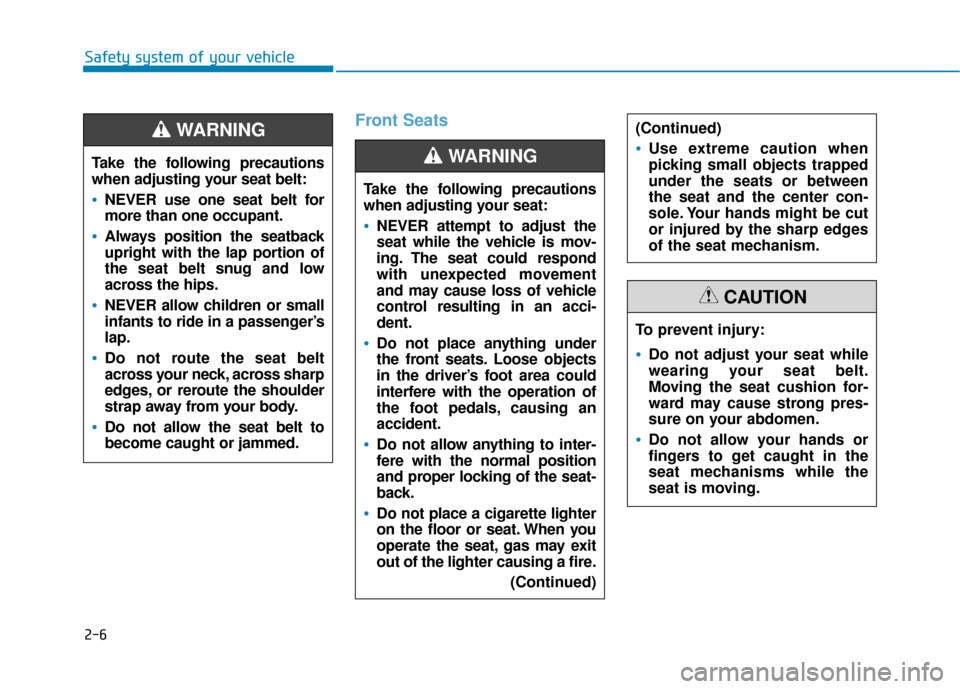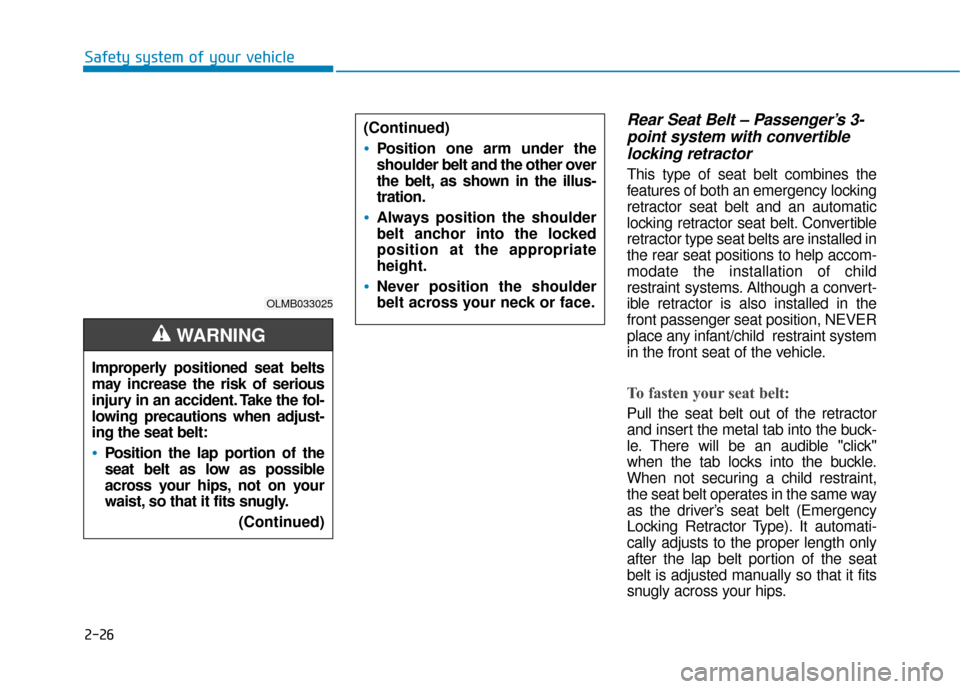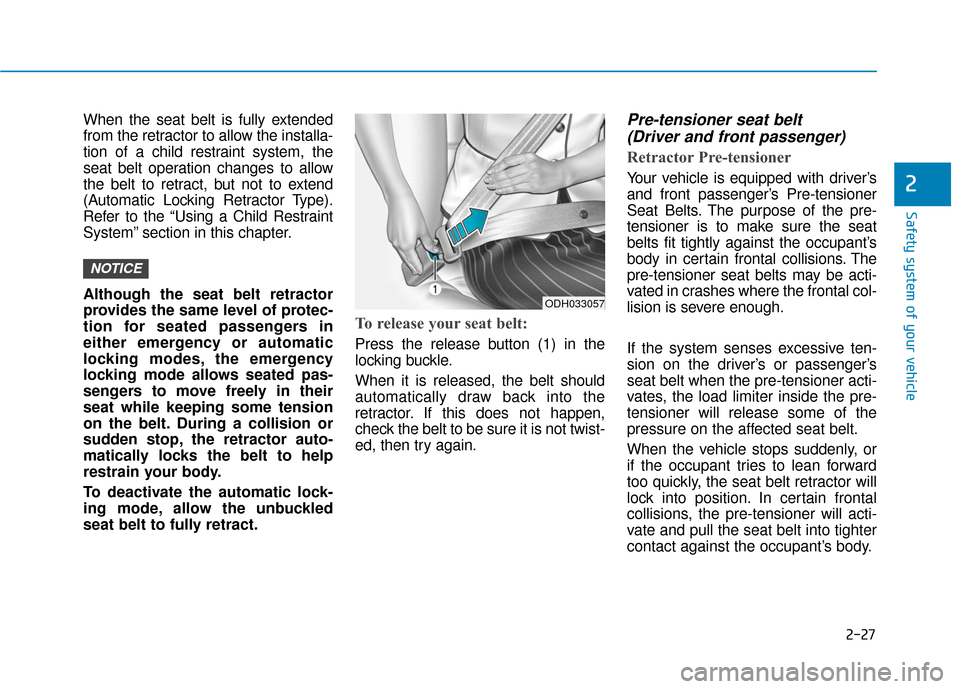2017 Hyundai Sonata Hybrid child lock
[x] Cancel search: child lockPage 13 of 562

I-2
A/V mode ........................................................................\
3-77
AFLS (Adaptive Front Lighting System) .....................3-116
Air bag warning labels....................................................2-68
Air bags ........................................................................\
...2-45Additional safety precautions .....................................2-67
Air bag collision sensors ............................................2-61
Air bag inflation conditions .......................................2-63
Air bag non-inflation conditions ................................2-64
Air bag warning labels ...............................................2-68
Curtain air bags ..........................................................2-49
Do not install a child restraint on the front passenger seat ...........................................................2-60
Driver’s front air bag..................................................2-47
Driver’s knee air bag ..................................................2-47
How does the air bag system operate? .......................2-50
Occupant classification system (OCS) .......................2-56
Passenger’s front air bag ............................................2-47
Side air bags ...............................................................2-48
SRS Care ....................................................................2-66\
SRS warning light ......................................................2-51
What to expect after an air bag inflates .....................2-55
Why didn’t my air bag go off in a collision ..............2-61
Air cleaner.......................................................................7\
-32
Air conditioner compressor label ...................................8-10
Air conditioning system (Refrigerant/Compressor) .........8-5
Air ventilation seats ........................................................2-21 Airconditioning system
Automatic climate control system............................3-139
Manual climate control system ................................3-129
Alarm system ..................................................................3-19
Antenna ........................................................................\
.....4-2
Anti-lock brake system (ABS) .......................................5-40
Appearance care..............................................................7-82 Exterior care ...............................................................7-82
Interior care ................................................................7-87
Armrest ........................................................................\
...2-14
Auto door lock/unlock features ......................................3-17
Auto hold ........................................................................\
5-37
Auto light position ........................................................3-109
Automatic climate control system ................................3-139 Air conditioning .......................................................3-146
Automatic heating and air conditioning ...................3-140
Climate control air filter...................................3-137, 149
Manual heating and air conditioning .......................3-141
Automatic transmission ..................................................5-14 Manual shift mode......................................................5-17
Automatic transmission shift indicator ...........................3-73
Automatic emergency braking (AEB) ............................5-81 System setting and activation .....................................5-81
AEB warning message and system control................5-83
Sensor to detect the distance from the vehicle in front (front radar) ................................................5-86
System malfunction ....................................................5-87
Limitation of the system ............................................5-89
AUX, USB and iPod
®port ...............................................4-2
Index
A
Page 14 of 562

I-3
Battery ........................................................................\
.....7-38
Battery saver function ...................................................3-115
Before driving ...................................................................5-4
Blind spot detection system (BSD) ................................5-73
Blind spot mirror.............................................................3-41
Brake fluid ......................................................................7-\
30
Brake system ...................................................................5-28Anti-lock brake system (ABS) ...................................5-40
Auto hold ....................................................................5-37\
Disc brakes wear indicator ........................................5-29
Electronic parking brake (EPB) .................................5-31
Electronic stability control (ESC) ..............................5-43
Hill-start assist control (HAC) ...................................5-46
Parking brake (Manual)..............................................5-29
Power brakes ..............................................................5-28
Bulb replacement ............................................................7-70
Bulb wattage .....................................................................8-3\
Button start/stop, see engine start/stop button ..................5-9 California perchlorate notice ..........................................7-93
Capacities (Lubricants) .....................................................8-6
Care
Exterior care ...............................................................7-82
Interior care ................................................................7-87
Tire care ......................................................................7-\
41
Center console storage ..................................................3-155
Central door lock switch .................................................3-16
Certification label .............................................................8-9
Chains Tire chains ..................................................................5-96
Checking tire inflation pressure ......................................7-43
Child restraint system (CRS) ..........................................2-34 Booster seats...............................................................2-37
Children always in the rear ........................................2-34
Forward-facing child seats ........................................2-37
Installing a Child Restraint System (CRS) ................2-37
Lower anchors and tether for children (LATCH) system .......................................................................2\
-38
Rear-facing child seats ..............................................2-36
Securing with lap/shoulder belt..................................2-42
Securing with LATCH anchors ..................................2-40
Securing with Tether anchors .....................................2-41
Selecting a Child Restraint System (CRS).................2-35
Child-protector rear door lock ........................................3-18
I
Index
BC
Page 15 of 562

I-4
Climate control air filter .......................................3-137, 149
Climate control air filter (Replacement).........................7-34
Clock ........................................................................\
.....3-160
Clothes hanger ..............................................................3-161
Combined instrument, see instrument cluster ................3-67
Compact spare tire ..........................................................6-20
Consumer information ....................................................8-11
Coolant ........................................................................\
....7-27
Cooling fluid, see engine coolant ...................................7-27
Cruise control system .....................................................5-50
Cup holder.....................................................................3-1\
57
Curtain air bags ...............................................................2-49
Dashboard illumination, see instrument panel illumination ...................................................................3-69
Dashboard, see instrument cluster ..................................3-67
Day/night rearview mirror ..............................................3-25
Daytime running light ...................................................3-116
Defogging (Windshield) ...............................................3-151
Defroster (Rear window) ..............................................3-128
Defrosting (Windshield) ...............................................3-151
Digital speedometer ........................................................3-96
Dimensions .......................................................................8\
-2
Disc brakes wear indicator ............................................5-29
Display illumination, see instrument panel illumination ...................................................................3-69 Displays, see instrument cluster .....................................3-67
Do not install a child restraint on the front
passenger seat ...............................................................2-60
Door courtesy lamp.......................................................3-120
Door locks .......................................................................3\
-14 Auto door lock/unlock features ..................................3-17
Central door lock switch ............................................3-16
Child-protector rear door lock....................................3-18
Drink holders, see cup holders .....................................3-157
Drive mode integrated control system ...........................5-48
Driver assist system Rear parking assist system (RPAS) ..........................3-125
Rear view camera .....................................................3-124
Driver position memory system ....................................3-20
Driver’s front air bag ......................................................2-47
Driver’s knee air bag ......................................................2-47
Driving at night ...............................................................5-94
Driving in flooded areas .................................................5-95
Driving in the rain...........................................................5-95
Dynamic bending light, see AFLS (Adaptive Front Lighting System)..............................3-116
Index
D
Page 34 of 562

Safety Precautions
Adjusting the seats so that you are sit-
ting in a safe, comfortable position
plays an important role in driver and
passenger safety together with the
seat belts and air bags in an accident.
Air bags
You can take steps to reduce the risk
of being injured by an inflating air
bag. Sitting too close to an air bag
greatly increases the risk of injury in
the event the air bag inflates.The National Highway Traffic Safety
Administration (NHTSA) recommends
that drivers allow at least 10 inches
(25 cm) between the center of the
steering wheel and their chest.
Seat belts
Always fasten your seat belt before
starting any trip.
At all times, passengers should sit
upright and be properly restrained.
Infants and small children must be
restrained in appropriate child restraint
systems. Children who have outgrown
a booster seat and adults must be
restrained using the seat belts.
Do not use a cushion that
reduces friction between the seat
and the passenger. The passen-
ger’s hips may slide under the
lap portion of the seat belt during
an accident or a sudden stop.
Serious or fatal internal injuries
could result because the seat
belt cannot operate properly.
WARNING To reduce the risk of serious
injury or death from an inflating
air bag, take the following pre-
cautions:
Adjust the driver’s seat as far to
the rear as possible while main-
taining the ability to maintain
full control of the vehicle.
Adjust the front passenger seat
as far to the rear as possible.
Hold the steering wheel by the
rim with hands at the 9 o’clock
and 3 o’clock positions to mini-
mize the risk of injuries to your
hands and arms.
NEVER place anything or any-
one between the steering wheel
and the air bag.
Do not allow the front passen-
ger to place feet or legs on the
dashboard to minimize the risk
of leg injuries.
WARNING
2-5
Safety system of your vehicle
2
Page 35 of 562

2-6
Safety system of your vehicle
Front Seats
Take the following precautions
when adjusting your seat belt:
NEVER use one seat belt for
more than one occupant.
Always position the seatback
upright with the lap portion of
the seat belt snug and low
across the hips.
NEVER allow children or small
infants to ride in a passenger’s
lap.
Do not route the seat belt
across your neck, across sharp
edges, or reroute the shoulder
strap away from your body.
Do not allow the seat belt to
become caught or jammed.
WARNING
Take the following precautions
when adjusting your seat:
NEVER attempt to adjust the
seat while the vehicle is mov-
ing. The seat could respond
with unexpected movement
and may cause loss of vehicle
control resulting in an acci-
dent.
Do not place anything under
the front seats. Loose objects
in the driver’s foot area could
interfere with the operation of
the foot pedals, causing an
accident.
Do not allow anything to inter-
fere with the normal position
and proper locking of the seat-
back.
Do not place a cigarette lighter
on the floor or seat. When you
operate the seat, gas may exit
out of the lighter causing a fire.(Continued)
WARNING
To prevent injury:
Do not adjust your seat while
wearing your seat belt.
Moving the seat cushion for-
ward may cause strong pres-
sure on your abdomen.
Do not allow your hands or
fingers to get caught in the
seat mechanisms while the
seat is moving.
CAUTION
(Continued)
Use extreme caution when
picking small objects trapped
under the seats or between
the seat and the center con-
sole. Your hands might be cut
or injured by the sharp edges
of the seat mechanism.
Page 55 of 562

2-26
Safety system of your vehicle
Rear Seat Belt – Passenger’s 3-point system with convertiblelocking retractor
This type of seat belt combines the
features of both an emergency locking
retractor seat belt and an automatic
locking retractor seat belt. Convertible
retractor type seat belts are installed in
the rear seat positions to help accom-
modate the installation of child
restraint systems. Although a convert-
ible retractor is also installed in the
front passenger seat position, NEVER
place any infant/child restraint system
in the front seat of the vehicle.
To fasten your seat belt:
Pull the seat belt out of the retractor
and insert the metal tab into the buck-
le. There will be an audible "click"
when the tab locks into the buckle.
When not securing a child restraint,
the seat belt operates in the same way
as the driver’s seat belt (Emergency
Locking Retractor Type). It automati-
cally adjusts to the proper length only
after the lap belt portion of the seat
belt is adjusted manually so that it fits
snugly across your hips.
(Continued)
Position one arm under the
shoulder belt and the other over
the belt, as shown in the illus-
tration.
Always position the shoulder
belt anchor into the locked
position at the appropriate
height.
Never position the shoulder
belt across your neck or face.
OLMB033025
Improperly positioned seat belts
may increase the risk of serious
injury in an accident. Take the fol-
lowing precautions when adjust-
ing the seat belt:
Position the lap portion of the
seat belt as low as possible
across your hips, not on your
waist, so that it fits snugly.
(Continued)
WARNING
Page 56 of 562

2-27
Safety system of your vehicle
2
When the seat belt is fully extended
from the retractor to allow the installa-
tion of a child restraint system, the
seat belt operation changes to allow
the belt to retract, but not to extend
(Automatic Locking Retractor Type).
Refer to the “Using a Child Restraint
System” section in this chapter.
Although the seat belt retractor
provides the same level of protec-
tion for seated passengers in
either emergency or automatic
locking modes, the emergency
locking mode allows seated pas-
sengers to move freely in their
seat while keeping some tension
on the belt. During a collision or
sudden stop, the retractor auto-
matically locks the belt to help
restrain your body.
To deactivate the automatic lock-
ing mode, allow the unbuckled
seat belt to fully retract.
To release your seat belt:
Press the release button (1) in the
locking buckle.
When it is released, the belt should
automatically draw back into the
retractor. If this does not happen,
check the belt to be sure it is not twist-
ed, then try again.
Pre-tensioner seat belt (Driver and front passenger)
Retractor Pre-tensioner
Your vehicle is equipped with driver’s
and front passenger’s Pre-tensioner
Seat Belts. The purpose of the pre-
tensioner is to make sure the seat
belts fit tightly against the occupant’s
body in certain frontal collisions. The
pre-tensioner seat belts may be acti-
vated in crashes where the frontal col-
lision is severe enough.
If the system senses excessive ten-
sion on the driver’s or passenger’s
seat belt when the pre-tensioner acti-
vates, the load limiter inside the pre-
tensioner will release some of the
pressure on the affected seat belt.
When the vehicle stops suddenly, or
if the occupant tries to lean forward
too quickly, the seat belt retractor will
lock into position. In certain frontal
collisions, the pre-tensioner will acti-
vate and pull the seat belt into tighter
contact against the occupant’s body.
NOTICE
ODH033057
Page 71 of 562

2-42
Safety system of your vehicle
Securing a child restraint witha lap belt or lap/shoulder belt
When not using the LATCH system,
all child restraints must be secured to
a vehicle rear seat with the lap part
of a lap/shoulder belt.
Automatic locking mode
Since all passenger seat belts move
freely under normal conditions and
only lock under extreme or emer-
gency conditions (emergency locking
mode), you must manually pull the
seat belt all the way out to shift the
retractor to the “Automatic Locking”
mode to secure a child restraint.
The “Automatic Locking” mode will
help prevent the normal movement
of the child in the vehicle from caus-
ing the seat belt to loosen and com-
promise the child restraint system. To
secure a child restraint system, use
the following procedure. To install a child restraint system on
the rear seats, do the following:
1. Place the child restraint system on
a rear seat and route the lap/shoul-
der belt around or through the child
restraint, following the restraint
manufacturer’s instructions.
Be sure the seat belt webbing is
not twisted.
When using the rear center seat
belt, you should also refer to the
“3-point Rear Center Seat Belt”
section in this chapter.
NOTICEALWAYS place a rear-facing
child restraint in the rear seat of
the vehicle.
Placing a rear-facing child
restraint in the front seat can
result in serious injury or death
if the child restraint is struck by
an inflating air bag.
WARNING
OLMB033044